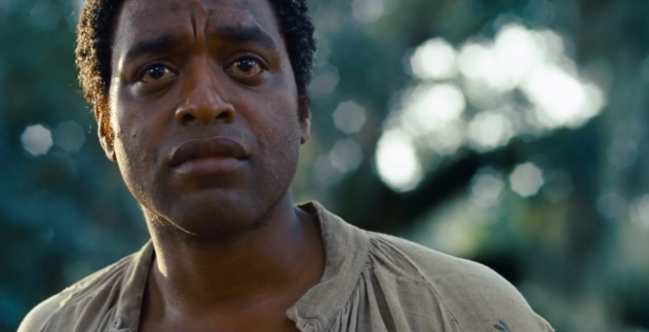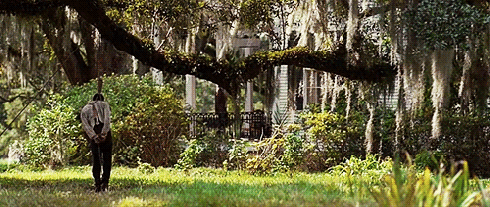‘Slave morality’, according to Nietzsche, was a deep-rooted desire to be led, to submit blindly and instinctively to authority, a desire, or disposition, that either started or became unconscious, automatic, and that, while often dressed up in rituals that imply a manifest, yes-we’re-aware-of-what-we’re-doing volition, was a wished-for subjugation all the same. Such a desire, he argued in The Genealogy of Morals, was the foundation of Christianity and the other monotheisms, although he saw it in many places: obedience, docility, prostration, servility – we are still a long way from having done with it all.
He would not have seen it so much, however, in the figure of Solomon Northrup whose extraordinary story was made into the one of the most extraordinary films of recent years.
Despite the appropriately brutal literalism of its title, this is a film not solely about slavery – that is, not exclusively about the nitty-gritty of the concrete, specific historical ignominy and abjection visited upon those whose backs were broken for the enrichment of a class of aristocrats à l’americain: the plantation owners of the South. (If one is keen to avoid the tired representation of African-Americans as victims in some way, then, arguably, the film can just as profitably be watched with the historical context bracketed off and the focus about the brutalism of abduction and human trafficking, which continues to this day.)
No, the other half of that title spells out that it is also a film about time – the crushing weight of time spent in labouring captivity, de-humanised by capricious ‘Masters’ – and about how to survive such a time. Some several years into this ordeal, Solomon believes – hopes – he has found someone to help extricate him from his predicament by delivering a message to his patron in the North who could explain that he is, in fact, a free man. He is double-crossed. Some quick-thinking spares him the lash, but he has to burn his letter, upon whose embers the camera lingers until the screen turns perfectly black. You hardly need be Roger Ebert to see the symbolism in this.
This is a film that grows remorselessly bleak – to present such material in any other way would be a travesty, of course. Thus, just when you think the fact of his being duped, abducted and sold into Southern bondage is pushing some sort of limits of immiseration, Solomon passes from the relatively benevolent patronage of Benedict Cumberbatch’s Ford to Michael Fassbender’s Epps – the difference between which is conveyed through their respective sermons – from which point onward the unflinching camera of director Steve McQueen heaps woe upon woe until the almost unbearable scene in which the young Patsy is forcibly flogged at the unwilling hands of a wretched Solomon as the Master looks on, braying, frothing, almost quivering with bloodlust. The sermon with which his character is introduced?
That nigger that don’t obey his Lord – that’s his Master, d’you see – that there nigger shall be beaten with many stripes. Now ‘many’ signifies a great many: forty, hundred, hundred and fifty lashes. That’s Scripture.
Having become a favourite of Epps, thus incurring the tenacious ire of his pious and sadistic wife, Patsy’s own survival strategy – at least, before she asks Solomon to end her misery – includes allowing herself to be raped (if that is not a grotesque oxymoron), advised to do so by Mistress Harriet Shaw, a former slave turned plantation-owner’s wife who “has not felt the end of a lash in I don’t know how many several years now, and instead of serving I have others serving me. If Massa Shaw’s show of fidelity is the price I gotta pay…” Pragmatism or slave morality?
Anyway, Patsy’s misdemeanour had simply been to make a journey to the Shaw plantation to pick up a small bar of soap, the dried-on stench of her labour nauseating even to herself. It is a right she implores Epps to grant – the least she deserves for her prodigious daily cotton-picking hauls – and yet one that brings her only rent flesh and unspeakable agony.
Patsy’s flogging stands out for its abjection, yet the single most powerful scene in an at times overwhelmingly desolate story (not movie) is perhaps when Solomon is saved from being lynched and – presumably because of some proprietorial code – left hanging from a tree, tip-toes in the mud his fragile connection to life, until his Master can be fetched to cut him down. Here the broad sense of a time spanning indeterminately into the future – slave time, if you will – is condensed into 309 harrowing seconds of screen time.
After he has overpowered Master Tibbeats (when the latter, unbidden, had tried to set about him with a bullwhip and retreated saying he’d have his “pound of flesh”), the camera lingers for 18 seconds on a panting Solomon, a medium-shot showing a man stiff with trepidation having momentarily upturned the institutionalised violence of this shameful social order. He’s warned by “the overseer” not to leave the plantation because, were he to do so, he cannot be protected, so we get 26 further seconds of silence (save for ominously discordant horns) and a longshot of Solomon from behind before a close-up a face over which plays the unmistakeable signs of fear.
The next 20 seconds show Tibbeats returning with two accomplices to drag a bound Solomon to a huge old weeping willow tree, where they start to lynch him until the overseer again intervenes – not out of any particular compassion, you understand, but simply because Northrup embodies a personal debt, a mortgage. He draws a gun, Tibbeats flees, and the overseer instructs someone to “get Master Ford”.
And then we see Solomon grimly hanging on for 91 seconds of screentime (during which the eye picks up fellow slaves getting on with some small chores, their quiescence – implanted through the whip – as disturbing as any of the violence), before some water is brought to him. Yet the terrible, terrible silence will not be broken for still another 90 seconds as we cut from a medium-shot of Solomon’s bound, twisted, limp body behind which the overseer paces the verandah, rifle in hand; we see kids skipping and playing obliviously; we see Solomon, almost choking, in grisly close-up; we see the Mistress Ford on the upper verandah, impassive; we see a shot from the slaves lodgings. And then, finally, he is cut free.
The horrific, excruciating longueur of this sequence seems somehow to capture the intense hopelessness of his circumstances (12 Years seems a relatively precise measure, but that’s after the fact, after being freed; during the experience, enduring it, the time would have stretched out infinitely).
Yet as well as the endless time there is a spatial dislocation that is every bit as entrapping. His escape routes seem closed – he doesn’t really know where he is, only that he has been transplanted from a comfortable life as a lawyer, a husband, a father, into an indescribable misery, and that he must deal only deal with his most immediate surrounds – and the bleakness encircles him, a fact that’s brought home when he’s asked to run an errand and charges blindly into the woods, only to come across a lynching of two “niggers”, presumably for the same crime.
And in this sense the plantation stands for the South as a whole, while Brad Pitt’s character, an itinerant labourer, is a cipher for the historical winds blowing in from the horizon, just a decade away in the form of the American Civil War.
Thus, the escape routes only seem closed. As ever, it is kindness that will spare him. And the perversity of it all is that he has been unspeakably lucky.
A masterpiece.

